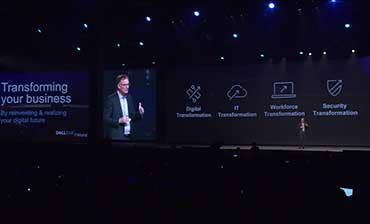Dell EMC's David Goulden: Modern, Automated Infrastructure Provides The First Step For Cloud Migration
A modern, automated, and transformational data center infrastructure is the key to businesses moving forward with the cloud and modern applications.
That's the word from Dell EMC President David Goulden who told attendees of this week's Dell EMC World conference that businesses need to move forward with their digital transformation, but only a few have done so.
Goulden also used his keynote to provide an overview of Dell EMC's new products, including the company's upcoming 14th generation of PowerEdge servers, a series of new storage products featuring increased use of flash and cloud technology, and new financial options for customers looking to adopt the latest technology.
[Related: Dell EMC Launches All-Flash Storage Barrage]
Goulden, citing a survey of 1,000 businesses from analyst firm Enterprise Strategy Group, said that most businesses have started the process, but only 5 percent have finished it.
CIOs are increasingly being asked to decide how to transform their business for modern infrastructures, and to look at when to use the cloud versus stay on-premises, Goulden said.
"This is where CIOs find themselves today: between a rock and a hard place," he said.
To be ready, Goulden said, businesses need to go through a three-step process: modernize the data center, automate it and transform it.
At the highest level, IT is all about the applications which are increasingly being run on a cloud, he said. "Of course, clouds run on IT infrastructures: services, storage, and networking," he said.
Dell EMC has a three-pronged strategy to help customers go through their digital transformation, Goulden said.
The first is to develop the right cloud strategy to meet diverse application needs, including the needs of general purpose applications, new cloud-native applications, and especially mission-critical applications, Goulden said. "These applications are often run on specific infrastructures that support these applications," he said.
Dell EMC has taken a leading role over all three application types, Goulden said.
For the vast majority of applications, Dell EMC offers its own hybrid cloud offering called Enterprise Hybrid Cloud, a turnkey platform based on VMware technology, Goulden said.
For mission-critical applications, the company offers Virtustream, which provides a public cloud infrastructure specifically designed for applications that require reliability. he said. Dell EMC on Monday introduced a new healthcare-specific version of Virtustream, he said. Sometime this year, Dell EMC will introduce the Enterprise Hybrid Cloud for Virtustream, he said.
Dell EMC's Pivotal technology offers a base on which modern cloud-native applications can be built, Goulden said. Pivotal has partnerships with Amazon Web Services, Google and Microsoft Azure, he said.
Dell EMC's second strategy is providing the data center infrastructure, which Goulden said is for many companies the first step in getting ready for the cloud. Dell EMC is using this week's Dell EMC World to roll out a wide range of new products to help customers modernize that infrastructure, he said.
"No one else is spending close to what we are spending on R&D," he said. "And nobody is innovating like we are."

New offerings include a new version of the VxRail hyper-converged infrastructure. VxRail 4.5 will be based on Dell's upcoming 14G server technology, and will have a starting price as low as $25,000, Goulden said. More important, Dell EMC is introducing a new pricing model for VxRail that requires no up-front costs and lets customers pay on a per-month basis and even return it after 12 months, if they want.
Dell EMC also offers Vblock converged infrastructure offerings, as well as best-of-breed servers, storage, networking and data protection for customers who prefer to assemble their own infrastructures, Goulden said.
To help Dell EMC introduce its coming 14G PowerEdge server line, the availability of which will depend on when Intel's Purley architecture becomes available, Goulden introduced Diane Bryant, the top executive of Intel's Data Center group, who is about to take a leave of absence.
Dell EMC's 14G servers are built on next-generation Xeon processing technology Intel plans to introduce this summer, Bryant said. The focus on the new Xeon platform will be on meeting the performance, security, and efficiency needs of cloud computing, and in helping customers develop data center infrastructures with the flexibility of the largest webscale providers, she said.
"With the innovation that Dell EMC has added, specifically in scalability and security, the 14G platform [provides] truly differentiated solutions," she said.
On the enterprise storage side, Goulden introduced the VMAX 950F which provides all-flash storage technology for mission-critical workloads; the XtremIO X2 second generation of XtremIO technology that can scale to up to 10 petabytes of capacity depending on the workload and the level of compression and de-duplication used; and a new version of ScaleIO scale-out storage which now scales to 1,000 nodes with new data efficiency technology that works across the entire cluster.
On the midrange storage side, Goulden introduces the next generation of Dell EMC's all-flash Unity unified file and block storage, along with the SC5020, the latest version of the affordable all-flash and hybrid flash family that came from Dell's 2011 acquisition of Compellent.
The third part of Dell EMC's strategy to help companies with digital transformation has to do with services and consumption.
Goulden said Dell EMC provides services via 60,000 Dell EMC people and partners who can help customers regardless of whether the customer wants capital purchases, a subscription service, or a pay-for-use service.